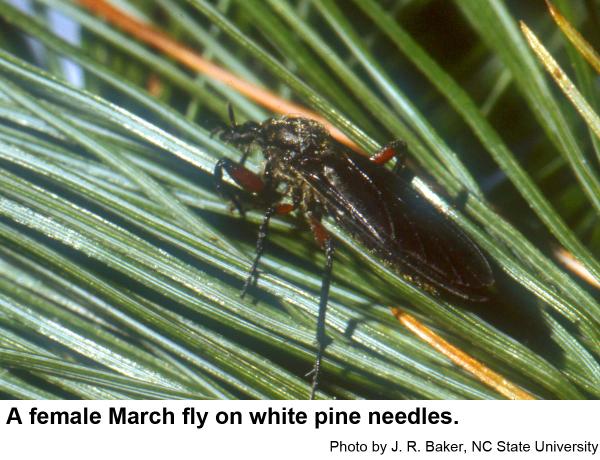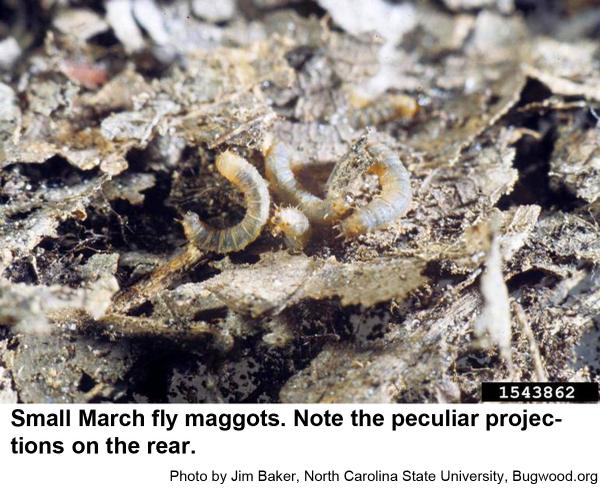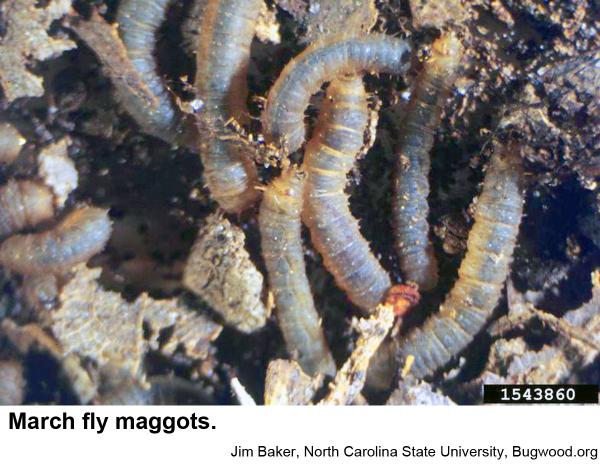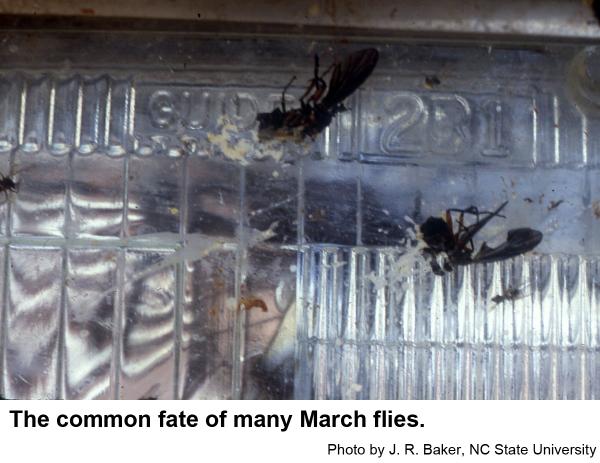General Information
March flies are a family of flies also called lovebugs (genus Plecia because they are often found in copula ), St Mark’s flies (genus Bibio and others because they are in flight around April 25, St. Mark's feast day), fever flies (genus Dilophus), and garden flies. March flies range from fragile to sturdy insects with relatively short antennae and dark bodies. Some species are marked with red or yellow spots. March flies are 1⁄4 to 1⁄2 inch long. March fly larvae are gray, leathery maggots with well defined heads. The body has numerous small bumps and protrusions. March fly maggots are 1⁄4 to 1 inch long. The pupae are slender and brownish.
Biology
March flies are found throughout North America, but large flights of March flies occur primarily in the southeastern United States. March fly maggots develop in decaying organic matter. Adults visit flowers presumably for nectar. The principal concern over March flies arises with the sudden appearance of swarms of these flies over ornamental and fruit crops and around homes. When their swarms cross roads and highways, large numbers splatter on trucks and automobiles. Visibility may be reduced, and when the flies are especially abundant, vehicles may overheat because the flies clog radiator fins. If left on car finishes too long, the fatty tissue of the flies and their eggs may pit or mar the paint.
After mating, female March flies enter the soil where they lay 200 to 300 eggs. Maggots hatch from the eggs and feed on leaf litter and sometimes among the roots of living plants. They have been reported from potatoes which had been previously damaged by wireworms. Their feeding hastens the breakdown of plant tissue into humus. March fly adults often emerge in early to late spring (sometimes in autumn as well). These flies visit flowers and are sometimes effective pollinators.
Control
March flies are a nuisance, but they do not represent any threat to the health of plants, animals or humans. The principal concern over March flies arises with the sudden appearance of swarms of these flies over ornamental and fruit crops and around homes. When their swarms cross roads and highways, large numbers splatter on trucks and automobiles. Visibility may be reduced, and when the flies are especially abundant, vehicles may overheat because the flies clog radiator fins. If left on car finishes too long, the fatty tissue of the flies and their un-laid eggs may pit or mar the paint. A large scale control of immature or adult March flies by chemical means would place an undue pesticide load on the environment. The most troublesome species of March flies swarm during warm daylight hours, so driving at night might avoid the problem for travelers. A screen across the front of the radiator will protect the radiator from clogging. Temporarily smearing the front of the car with baby oil or spraying it with a no-stick cooking product will aid in the removal of splattered flies later.
Other Resources
- Black Thorn (Hawthorn fly). Sjöstrand, M. 1999. Rackelhanen - Flyfishing Magazine.
- Common name: lovebug, scientific name: Plecia nearctica Hardy (Insecta: Diptera: Bibionidae). Denmark, H. A, F.W. Mead, and T. R. Fasulo. 2018 (reviewed). Florida Department of Agriculture & Consumer Services, Division of Plant Industry. Publication No. EENY-47
- Family Bibionidae - March Flies. Coin, P. et al. 2014 (update). BugGuide. Iowa State Univ. Dept. Entomology.
- Lovebugs in Florida. J. Weston, J., D. E. Short, and M. P. Lehnert. 2008. Department of Entomology and Nematology, UF/IFAS Extension, Gainesville, FL
- March Flies. Anonymous. No Date. Colorado State University
- March Flies. Rosetta, R. L. 2016 (update). Pacific Northwest Nursery IPM, Insects. Oregon State University.
- March Flies, Family Bibionidae. Kulzer, L. 1994. BUG OF THE MONTH: April 1994
- NC State Extension Plant Pathology Publications
- NC State Horticultural Science Publications
- North Carolina Agricultural Chemicals Manual
For assistance with a specific problem, contact your local N.C. Cooperative Extension center.
Publication date: May 1, 1997
Reviewed/Revised: Nov. 16, 2020
N.C. Cooperative Extension prohibits discrimination and harassment regardless of age, color, disability, family and marital status, gender identity, national origin, political beliefs, race, religion, sex (including pregnancy), sexual orientation and veteran status.






